Scottish Health Survey 2018: main report - revised 2020
An amended version of the Scottish Health Survey 2018 main report.
Chapter 4 Smoking
Summary
19% of adults smoked in 2018. This was not significantly different to 2017, but the rate has fallen significantly since 2003 (28%).
The percentage of adults who had never smoked regularly or at all was at its highest level in 2018 at 59%. The figure had risen from 50% in 2003 to 55% in 2011 and since then had remained fairly stable (54–56%) until the increase in 2018.
There has been a steady decline over time in the mean number of cigarettes smoked per day by current adult smokers; in 2003, the average was 15.3, falling to 11.8 per day in 2018.
- 17% of women reported they currently smoked in 2018, down from 28% in 2003.
- 21% of men reported they currently smoked in 2018, down from 29% in 2003.
The mean number of cigarettes smoked per day among current smokers increased with age, from 7.8 among those aged 16-24 to 16.2 among those aged 65-74; there was a subsequent decline to an average of 13.3 cigarettes per day among those aged 75 and over.
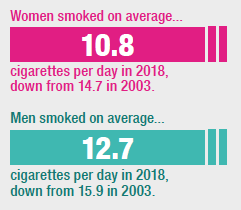
In 2018, adults living in the most deprived areas continued to be around 3 times more likely to smoke than those in the least deprived areas.
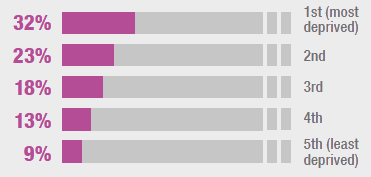
Current smoker prevalence was highest among those aged 25-54.
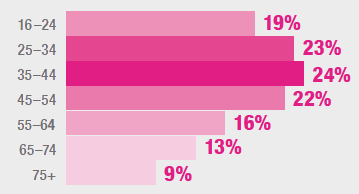
As in every year since 2015, the proportion of current e-cigarette users in 2018 was 7%, having increased from 5% in 2014.

In 2018, a higher proportion of men than women reported currently using e-cigarettes; in previous recent years there had been no significant difference between the sexes (in 2016 and 2017 7% of both men and women were current users).
- 6% of women used e-cigarettes.
- 8% of men used e-cigarettes.
The prevalence of e-cigarette use was highest among the middle age groups (8-11% among those aged 25-54) and lower for the youngest (5% among those aged 16-24) and older adults (1-6% for those aged 55 and over).
The proportion of current e-cigarette users who were also current regular smokers was significantly lower in 2017/18 combined (42%) than in 2014/15 combined (60%).
In 2018, among ex-smokers or those who had attempted to stop smoking, 27% had used nicotine gum, nicotine patches, a nasal spray/nicotine inhaler or lozenges/microtabs, around a fifth (18%) had used an electronic cigarette/vaping device and 5% had used prescriptions of Champix/Valenicline or Zyban/Bupropian in their most recent attempt to quit. Over half (59%) had not used any Nicotine Replacement Therapy (NRT) or other product in their attempt to quit.
The percentages of adults who had used these types of NRT or other product and found that they helped them to successfully stop smoking for a month or more were:

4 Smoking
Lucy Dean and Kasmita Mirani
4.1 Introduction
Tobacco use is a leading cause of premature mortality and preventable poor health worldwide[1] and, in Scotland, is associated with around 10,000 deaths and an estimated 100,552 hospital admissions per year[2]. Tobacco use is associated with stillbirths and infant deaths, childhood respiratory diseases, and communicable as well as non-communicable diseases in adulthood[3]. As the cause of one in five deaths, smoking represents the chief threat to Scotland's public health[4]. Smoking rates in the most deprived areas are highest making smoking a key health inequality challenge[5].
The risks associated with smoking increase the longer a person continues smoking, however, these risks reduce substantially (even amongst long-term smokers) when a person stops, adding further weight to the importance of cessation policies, initiatives and interventions[6]. Smoking cessation interventions, including pharmacotherapy, are among the most cost-effective health care interventions available[7].
4.1.1 Policy background
One of the Scottish Government's National Outcomes is the overall strategic objective for health: 'We are healthy and active'[8]. This is supported by a National Indicator that monitors (using Scottish Health Survey (SHeS) data) participation in health risk behaviours, including smoking, against an outcome of reducing the percentage of adults exhibiting two or more of these behaviours [9] as well as more general health related indicators including healthy life expectancy and premature mortality.
In 2013, the Scottish Government set out its ambition to create a 'tobacco-free generation' (defined as 'a smoking prevalence among the adult population of 5% or lower') by the year 2034. This was followed in June 2018 by the publication of Raising Scotland's Tobacco-free Generation[10], an updated action plan outlining interventions and policies that aim to ensure that when those born in 2013 reach the age of 21 they will be a 'tobacco free' generation. The actions include awareness raising campaigns, encouraging healthier behaviour in public settings, improving cessation services, regulations on smoking in prisons and the advertisement of e-cigarettes and restrictions on heated tobacco products. In addition, the Scottish Prison Service set the target for all prisons in Scotland to be smoke-free by the end of 2018[11].
Working with COSLA, NHS Health Scotland published Smoke-free Local Authority Implementation Guidance[12] in January 2017 to facilitate actions related to smoking prevention, protection and cessation. The NHS Local Delivery Plan (LDP) Standards[13], while delivering a universal smoking cessation offer, is focused primarily on the target of helping those living in Scotland's most deprived areas. The targeting of these areas through LDP Standards has been recognised by organisations such as Cancer Research UK as a positive approach to tackling this health inequality[14].
The Health (Tobacco, Nicotine etc. and Care) (Scotland) Act 2016[15] commenced on 1 April 2017. The Act includes provisions to regulate:
- the introduction of a minimum age of 18 for the sale of Nicotine Vapour Products (NVPs) – including electronic cigarettes
- a ban on the purchase of NVPs on behalf of an under 18 – 'proxy purchase'
- the introduction of mandatory registration for the sale of NVPs
- bans on certain forms of domestic advertising and promotion of NVPs
- the introduction of an age verification policy for sales of tobacco and NVPs by under 18s ('Challenge 25')
- a prohibition on the sale of NVPs from vending machines.
- a ban on unauthorised sales of tobacco and NVPs by under 18s
- the introduction of statutory smoke-free perimeters around buildings on NHS hospital sites.
Regulation on most of these provisions came into force in 2017.
The most recent primary legislation on smoking passed by the Scottish Parliament is the Smoking Prohibition (Children in Motor Vehicles) (Scotland) Act 2016 which deems as an offence smoking in cars in a public place in the presence of children[16].
Across the UK new regulations came into force on 21 May 2017 making it an offence to sell cigarettes in any pack containing less than 20 cigarettes, and ensuring all cigarettes are sold in standardised brand-neutral packs[17].
One set of these new regulations also restricted the strength, availability and access to electronic cigarettes – banning cross-border advertising and promotion on TV, radio, online, by e-mail and in print media.
4.1.2 Reporting on smoking in the Scottish Health Survey (SHeS)
Reliable data on smoking behaviour, cessation, nicotine replacement therapy (NRT) use and exposure to second-hand smoke are vital to effective monitoring of trends relevant to the various targets in place. This chapter presents prevalence of adult cigarette smoking and e-cigarette use for 2018 as well as trends in prevalence of both. The cigarette smoking status of current e-cigarette users is reported as well as exposure to second-hand smoke among children and the use of NRT that helped successful smoking cessation among adults.
The area deprivation data are presented in Scottish Index of Multiple Deprivation (SIMD) quintiles. Readers should refer to the Glossary at the end of this Volume for a detailed description of SIMD.
Supplementary tables are also available on the Scottish Government SHeS website[18].
4.1.3 Comparability with other UK statistics
The Health Survey for England, Health Survey for Northern Ireland and the National Survey for Wales provide estimates of smoking prevalence in the other home nations within the UK. The surveys are conducted separately and have different sampling methodologies, so smoking prevalence estimates across the surveys are only partially comparable[19]. Smoking prevalence estimates from the UK-wide Integrated Household Survey for Scotland, Wales, England and Northern Ireland have been deemed to be fully comparable[20].
4.2 Methods And Definitions
4.2.1 Methods of collecting data on smoking behaviour
Adults aged 20 and over were asked about their smoking behaviour during the face to face interview. For those aged 16 and 17, information was collected in a self-completion questionnaire offering more privacy and reducing the likelihood of concealing behaviour in front of other household members. At the interviewer's discretion those aged 18 and 19 could answer the questions either face to face or via the self-completion booklet.
4.2.2 Questions on smoking behaviour
Questions on smoking have been included in SHeS since 1995. Some small changes were made to the questions in 2008 and 2012. These are outlined in the relevant annual reports[21],[22].
The current questions in the survey focus on:
- current smoking status
- frequency and pattern of current smoking
- the number of cigarettes smoked by current smokers
- ex-smokers' previous smoking history
- exposure to second-hand smoke
- past smoking behaviour
- quit attempts and desire to give up smoking
- medical advice on giving up smoking
- NRT use (now including questions on NRT that led to successful cessation)
- e-cigarette use (including as part of a quit attempt).
While the self-completion questions were largely similar to those asked in the face to face interview, the self-completion questionnaire did exclude questions on: past smoking behaviour, desire to give up smoking and medical advice to stop smoking.
4.2.3 Questions on e-cigarette use
From 2014, SHeS has gathered information on the use of e-cigarettes among the Scottish adult population, in response to their increased availability and high profile. The questions ask whether participants have ever used an e-cigarette as well as whether they are currently using an e-cigarette.
4.2.4 Definitions
Cigarette smoking status
Information on cigar and pipe use is collected in the survey but as prevalence is low these are not considered in the definition of current smoking. Smoking status categories reported here are:
- current cigarette smoker
- ex-regular cigarette smoker
- never regular cigarette smoker
- never smoked cigarettes at all
Exposure to second-hand smoke
Exposure to second-hand smoke for children is measured in two ways in the survey:
- whether there is someone who regularly smokes inside the accommodation where the child lives, and
- parents' and older children's (aged 13-15) reports of whether children are exposed to smoke at home.
4.3 Cigarette Smoking Status
4.3.1 Trends in cigarette smoking status since 2003
Smoking prevalence among adults fell significantly from 28% in 2003 to 21% by 2013, then remained around this level before dropping to 18% in 2017. In 2018, 19% of all adults were smokers, this was not significantly different to the previous year (18%). This pattern was the same for men and women, whereby the rate of smoking prevalence dropped significantly between 2003 and 2013, stabilised for a few years then dropped once more. For most years, men were slightly more likely to be smokers than women were.
Figure 4A, Table 4.1
Figure 4A
Current cigarette smoking prevalence among adults aged 16+, 2003-2018, by sex
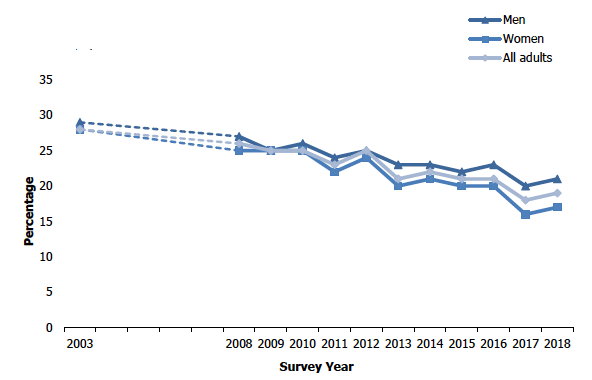
The percentage of adults who had never smoked regularly or had never smoked at all was at its highest level in 2018 at 59%. The figure had risen from 50% in 2003 to 55% in 2011 and since then had remained fairly stable (54-56%) until the increase in 2018. The percentage of all adults reporting that they were ex-regular smokers increased between 2003 (22%) and 2017 (26%) before dropping significantly in 2018 (22%). The trends in those reporting that they had never smoked or were ex-regular smokers were similar for men and women.
There has been a steady decline over time in the mean number of cigarettes smoked per day by current adult smokers. In 2003, the average was 15.3, falling to 11.8 per day in 2018. This pattern was similar among both men and women (from 15.9 in 2003 to 12.7 in 2018 for men, and from 14.7 in 2003 to 10.8 in 2018 for women).
Figure 4B, Table 4.1
Figure 4B
Mean number of cigarettes smoked per day among current smoking adults, 2003 to 2018, by sex
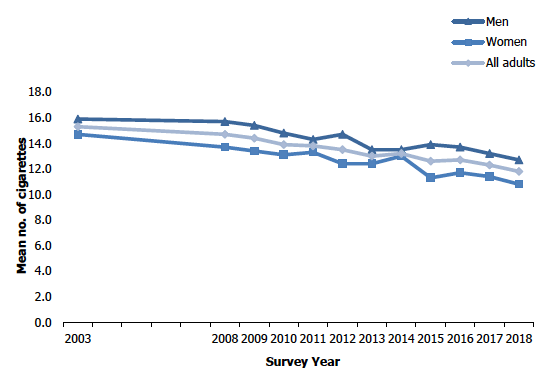
4.3.2 Cigarette smoking status in 2018, by age and sex
A higher proportion of men than women in 2018 identified as a current smoker (21% and 17% respectively). Similarly, men reported smoking more cigarettes on average per day (12.7) compared with women (10.8).
There were significant differences in smoking prevalence by age group in 2018, as seen in previous years[23]. Those aged 25-54 had the highest prevalence (22-24%). This compared to about a fifth (19%) of those aged 16-24, 16% of those aged 55-64, 13% of those aged 65-74 and 9% of those aged 75 and over.
However, the mean number of cigarettes smoked per day among current smokers increased with age up to age 65-74, from 7.8 among those aged 16-24 to 16.2 among those aged 65-74. There was a subsequent decline to an average of 13.3 cigarettes per day among those aged 75 and over. This pattern was similar for men and women, although among men, those aged 65-74 smoked the highest number of cigarettes on average per day (19.3), whereas among women, those aged 75 and over smoked the highest number per day (13.6).
As in previous years[24], there was a significant association between age and previous smoking status. The proportion of ex-smokers was highest among those in the older age groups and there was a corresponding decline by age in the proportion of those that had never smoked regularly. Around a third (34%) of adults aged 65 and over reported being an ex-smoker, with 53-57% never having been a regular smoker. This is compared with adults aged 16-24, of whom 3% reported being ex-smokers and 79% having never having been a regular smoker. Similar patterns were seen for men and women.
Table 4.2
4.3.3 Cigarette smoking status (age-standardised) since 2003, by area deprivation and sex
As in previous years[25], adults living in more deprived areas were more likely to smoke than those in less deprived areas in 2018. Smoking prevalence was 32% among those in the most deprived areas with step-decreases across the intermediate quintiles to 9% among those in the least deprived areas. This pattern was similar for men (33% in the most deprived areas compared with 10% in the least deprived areas) and women (30% in the most deprived areas compared with 8% in the least deprived areas).
In 2018, there was a clear increase by area deprivation in the numbers of cigarettes smoked with a mean of 13.2 cigarettes smoked per day among smokers in the most deprived areas and 9.4 cigarettes smoked among those in the least deprived areas. A similar gradient was seen for men and women.
Since 2003, both smoking rates and the average number of cigarettes smoked have reduced significantly in all deprivation quintiles. The gap between smoking prevalence in the most deprived and least deprived areas has narrowed, from 28 percentage points in 2003 (45% in most deprived and 17% in least deprived) to 23 percentage points in 2018 (32% in the most deprived and 9% in the least deprived) however rates remain around 3 times higher in the most deprived areas.
Table 4.3
4.4 Exposure To Second Hand Smoke
4.4.1 Children's exposure to second-hand smoke since 2012
In 2018, about a tenth (11%) of children lived in accommodation in which someone regularly smokes indoors. This figure has declined over time from 19% in 2012 to 12% in 2015 and has remained around that level since. This decline was observed for both boys and girls.
In 2018, 6% of children were reported to be exposed to second-hand smoke in their home. This figure declined from 12% in 2012 to 6% in 2015 and has remained around this level (6-7%) since. There was no significant difference between the proportions of boys and girls who were reported as having been exposed to second-hand smoke in their home in 2018.
Figure 4C, Table 4.4
Figure 4C
Percentage of children exposed to second-hand smoke in their own home, 2012 to 2018, by sex
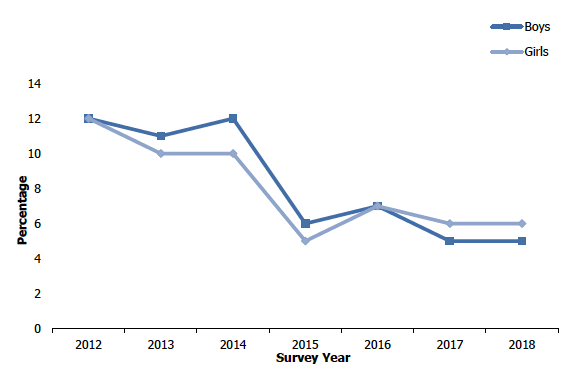
4.5 Use Of NRT and Other Products In Most Recent Attempt To Quit Smoking
4.5.1 Use of NRT and other products 2018, by age and sex
In 2018, among ex-smokers or those who had attempted to stop smoking, 27% had used nicotine gum, nicotine patches, a nasal spray/nicotine inhaler or lozenges/microtabs, around a fifth (18%) had used an electronic cigarette/vaping device and 5% had used prescriptions of Champix/Valenicline or Zyban/Bupropian; over half (59%) had not used any of these products. Similar levels were found for men and women.
The use of nicotine gum, nicotine patches, a nasal spray/nicotine inhaler or lozenges/microtabs varied by age, with higher proportions of middle aged adults using them (24-35% of those aged 25-74) than younger (12% of those aged 16-24) or older adults (18% of those aged 75 and over). Use of nicotine gum, nicotine patches, a nasal spray/nicotine inhaler or lozenges/microtabs differed by age for men and women, largely due to differences in the 25-34 age group (30% of women compared to 18% of men) and among those aged 75 and over (25% of women compared to 11% of men).
Use of electronic cigarette/vaping devices was highest among adults aged 16-24 (32%) with a stepped decrease across the age groups to lowest used among those aged 75 and over (5%). Slightly different patterns of electronic cigarette/vaping device use by age were found for men and women. For men there was a general decline by age (31-32% for those aged 16-34, 17-22% for those aged 35-64 and 6-7% for those aged 65 and over). For women use was highest among those aged 16-24 (32%) but comparatively low for those aged 25-34 (17%), levels of use then declined from 26% of those aged 35-44 to 6% of those aged 75 and over.
There were no significant differences in use of Varenicline or Bupropion by age or sex.
Table 4.5
4.5.2 Use of NRT and other products that helped successful smoking cessation, 2018, by sex
Among adults who had used nicotine gum, nicotine patches, a nasal spray/nicotine inhaler or lozenges/microtabs as part of their most recent quit attempt 51% reported these NRT products had helped them to successfully stop smoking for a month or more. This did not differ significantly between men and women.
Among adults who had used Varenicline and Bupropion as part of their most recent quit attempt, 67% reported that these products had helped them to successfully stop smoking for a month or more. This did not differ significantly between men and women.
Among adults who had used electronic cigarettes/vaping devices as part of their most recent quit attempt 59% reported that this had helped them to successfully stop smoking for a month or more. This did not differ significantly between men and women.
Table 4.6
4.6 E-Cigarette Use
4.6.1 Trends in E-Cigarette use since 2014, by age and sex
In 2018, current e-cigarette use among adults was 7%. A separate 11% had previously used e-cigarettes (with a total of 18% ever using them). Over four fifths (82%) had never used e-cigarettes.
The proportion of current e-cigarette users has remained stable at 7% since 2015, having increased from 5% in 2014. The proportion of adults that had previously used e-cigarettes has fluctuated between 10-12% since 2014 (10% in 2014 and 11% in 2018). Fewer adults reported never having used e-cigarettes in 2018 (82%) than in 2014 (85%).
In 2018 a significantly higher proportion of men reported currently using e-cigarettes compared with women (8% and 6% respectively), whilst in previous recent years there has been no significant difference (in 2016 and 2017 7% of both men and women were current users). As in previous years[26], in 2018, men were more likely to have previously used e-cigarettes than women (12% compared with 10%) and women were more likely than men to have never used e-cigarettes (84% compared with 80%).
Figure 4F, Table 4.7
Figure 4F
E-cigarette use 2014-2018- whether ever used, by sex
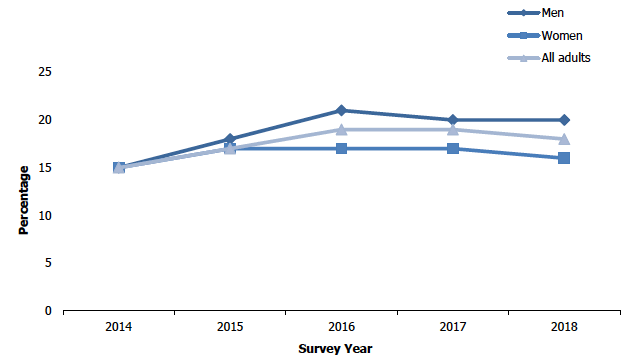
As in previous years[27], e-cigarette use in 2018 varied significantly with age. The prevalence of e-cigarette use was highest among the middle age groups (8-11% among those aged 25-54) and lower for the youngest (5% among those aged 16-24) and older adults (1-6% for those aged 55 and over). Different age-related patterns were seen for men and women; prevalence was highest among men aged 25-34 (14%) and among women prevalence was highest among those aged 45-54 (11%).
Combined past and current usage – ever use – was associated with younger age in 2018, with lower use among older adults. Of those aged 16-54, 18-26% had ever used e-cigarettes compared with 15% of those aged 54-65, 11% of those aged 65-74 and 5% of those aged 75 and over. For adults aged 35-74, around half of those who had ever used e-cigarettes (8-21%) were still using them (5-11%). This compared with around a fifth of adults aged 16-24 who had ever used e-cigarettes currently using them (5% were current users compared with 23% that reported having ever used e-cigarettes). Similar patterns were found for men and women.
Figure 4G, Table 4.7
Figure 4G
E-cigarette use 2014-2018- whether ever used, by age in 2018
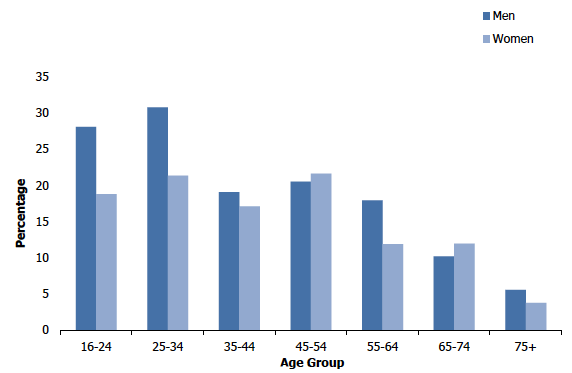
Age-related patterns in e-cigarette use have been similar since 2014.
4.6.2 Cigarette smoking status 2014/15 combined and 2017/18 combined, by e-cigarette use and sex
The proportion of current e-cigarette users who were also current regular smokers was significantly lower in 2017/18 combined than in 2014/15 combined 42% and 60% respectively. In 2017/18 combined more than half of current e-cigarette users (54%) used to smoke regularly, a significantly higher proportion than in 2014/15 (37%). The proportion of current e-cigarette users who had never smoked or used to smoke occasionally did not change significantly between 2014/15 combined (3%) and 2017/18 combined (4%).
Similar patterns were found for both men and women.
Table 4.8
References and notes
1. World Health Organisation (2019) Tobacco. See: https://www.who.int/news-room/fact-sheets/detail/tobacco
2. See: https://www.scotpho.org.uk/behaviour/tobacco-use/key-points/
3. World Health Organisation (2014). Tobacco and Inequities: Guidance for addressing inequities in Tobacco-related harm. Available from: http://www.euro.who.int/en/publications/abstracts/tobacco-and-inequities.-guidance-for-addressing-inequities-in-tobacco-related-harm-2014
4. Raising Scotland's tobacco-free generation: our tobacco control action plan 2018. Edinburgh: Scottish Government, 2018. Available from: https://www.gov.scot/publications/raising-scotlands-tobacco-free-generation-tobacco-control-action-plan-2018/
5. See: http://www.healthscotland.scot/news/2018/june/welcoming-scotland-s-tobacco-control-action- plan
6. See https://www.scotpho.org.uk/behaviour/tobacco-use/key-points
7. A guide to smoking cessation in Scotland. Edinburgh: NHS Scotland, 2017. Available from: www.healthscotland.com/uploads/documents/19844-PlanningAndProvidingSpecialistSmokingCessationServices.pdf
8. The National Performance Framework is described here: https://nationalperformance.gov.scot/
9. See: https://nationalperformance.gov.scot/measuring-progress/national-indicator-performance
10. Raising Scotland's tobacco-free generation: our tobacco control action plan 2018. Edinburgh: Scottish Government, 2018. Available from: https://www.gov.scot/publications/raising-scotlands-tobacco-free-generation- tobacco-control-action-plan-2018/
11. See: http://www.sps.gov.uk/Corporate/News/Creating_a_Smoke_Free_Prison_Environment.aspx
12. Smoke-free local authority implementation guidance. Edinburgh: NHS Health Scotland, 2017. Available from: http://www.healthscotland.scot/media/1277/smoke-free-local-authority-implementation-guidance-jan2017-english.pdf
13. 13 See:https://www2.gov.scot/About/Performance/scotPerforms/NHSScotlandperformance/Smoking-LDP
14. Caroline Smith, Sarah Hill, and Amanda Amos (2018) Stop Smoking Inequalities: A systematic review of socioeconomic inequalities in experiences of smoking cessation interventions in the UK.Cancer Research UK. Available from:
https://www.cancerresearchuk.org/sites/default/files/stop_smoking_inequalities_2018.pdf
15. See http://www.legislation.gov.uk/asp/2016/14/pdfs/asp_20160014_en.pdf
16. Smoking Prohibition (Children in Motor Vehicles) (Scotland) Act 2016. See: http://www.legislation.gov.uk/asp/2016/3/contents
18. See: www.gov.scot/scottishhealthsurvey
19. Government Statistical Service (2014). Comparing official statistics across the UK. Available from: http://gss.civilservice.gov.uk/wp-content/uploads/2014/02/Comparability-Report-Final.pdf
21. Gray L & Leyland AH (2009). Chapter 4: Smoking. In: Bromley, C., Bradshaw, P. and Given, L. (eds.) The 2008 Scottish Health Survey – Volume 1: Main Report. Edinburgh: Scottish Government. 2009. www.gov.scot/Publications/2009/09/28102003/0
22. Gray L & Leyland AH (2013). Chapter 4: Smoking. In: Rutherford, L., Hinchliffe, S. and Sharp, C. (eds.) The Scottish Health Survey 2012 – Volume 1: Main Report. Edinburgh: Scottish Government. Available from: www.gov.scot/Publications/2013/09/3684
23. Gray, L. and Leyland, A.H. (2018). Smoking. McLean, J., Christie, S., and Gray, L. (eds). The Scottish Health Survey – 2017 edition: volume 1: main report. Edinburgh: Scottish Government. Available from: https://www.gov.scot/publications/scottish-health-survey-2017-volume-1-main-report/pages/62/
24. Gray, L. and Leyland, A.H. (2018). Smoking. McLean, J., Christie, S., and Gray, L. (eds). The Scottish Health Survey – 2017 edition: volume 1: main report. Edinburgh: Scottish Government. Available from: https://www.gov.scot/publications/scottish-health-survey-2017-volume-1-main-report/pages/62/
25. Gray, L. and Leyland, A.H. (2018). Smoking. McLean, J., Christie, S., and Gray, L. (eds). The Scottish Health Survey – 2017 edition: volume 1: main report. Edinburgh: Scottish Government. Available from: https://www.gov.scot/publications/scottish-health-survey-2017-volume-1-main-report/pages/62/
26. Gray, L. and Leyland, A.H. (2018). Smoking. McLean, J., Christie, S., and Gray, L. (eds). The Scottish Health Survey – 2017 edition: volume 1: main report. Edinburgh: Scottish Government. Available from: https://www.gov.scot/publications/scottish-health-survey-2017-volume-1-main-report/pages/62/
27. Gray, L. and Leyland, A.H. (2018). Smoking. McLean, J., Christie, S., and Gray, L. (eds). The Scottish Health Survey – 2017 edition: volume 1: main report. Edinburgh: Scottish Government. Available from: https://www.gov.scot/publications/scottish-health-survey-2017-volume-1-main-report/pages/62/
Table list
Table 4.1 Cigarette smoking status, 2003 to 2018
Table 4.2 Cigarette smoking status, 2018, by age and sex
Table 4.3 Cigarette smoking status, (age-standardised), 2003 to 2018, by area deprivation and sex
Table 4.4 Children's exposure to second-hand smoke, 2012 to 2018
Table 4.5 Use of NRT and other products 2018, age and sex
Table 4.6 Use of NRT and other products that helped successful smoking cessation, 2018, by sex
Table 4.7 E-cigarette use 2014 to 2018, by age and sex
Table 4.8 Cigarette smoking status, 2014/15 combined and 2017/18 combined, by e-cigarette use and sex
Contact
There is a problem
Thanks for your feedback